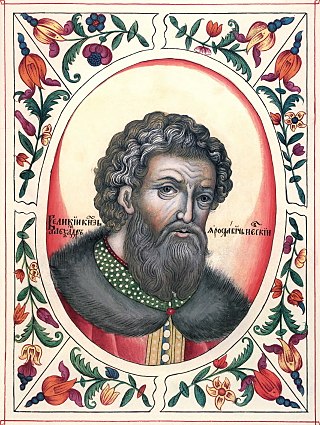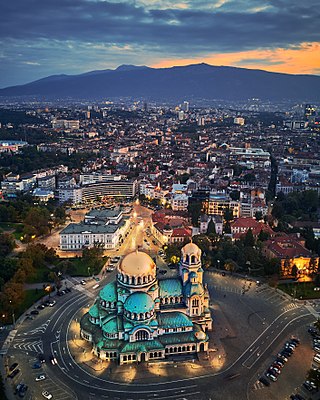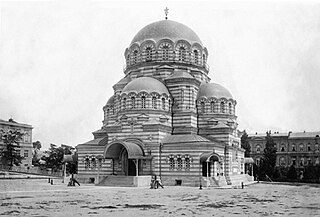
Alexander Yaroslavich Nevsky was Prince of Novgorod, Grand Prince of Kiev (1246–1263) and Grand Prince of Vladimir (1252–1263).
The year 1826 in architecture involved some significant architectural events and new buildings.

Neo-Byzantine architecture was a revival movement, most frequently seen in religious, institutional and public buildings. It incorporates elements of the Byzantine style associated with Eastern and Orthodox Christian architecture dating from the 5th through 11th centuries, notably that of Constantinople and the Exarchate of Ravenna.

St. Alexander Nevsky Cathedral is a Bulgarian Orthodox cathedral in Sofia, the capital of Bulgaria. Built in Neo-Byzantine style, it serves as the cathedral church of the Patriarch of Bulgaria and it is one of the 50 largest Christian church buildings by volume in the world. It is one of Sofia's symbols and primary tourist attractions. St. Alexander Nevsky Cathedral in Sofia occupies an area of 3,170 square metres (34,100 sq ft) and can hold 5,000 people inside. It is among the 10 largest Eastern Orthodox church buildings. It is the largest cathedral in the Balkans. It is believed that up until the year 2000 it was the largest finished Orthodox cathedral.


The Alexander Nevsky Cathedral is an orthodox cathedral on Toompea hill in central Tallinn, Estonia. It was built to a design by Mikhail Preobrazhensky in a typical Russian Revival style in 1894–1900, when the country was part of the Russian Empire. The cathedral is Tallinn's largest orthodox cupola church. It is dedicated to the grand prince of Kiev, and later saint, Alexander Nevsky who in 1242 won the Battle of the Ice on Lake Peipus, near the present-day border between Estonia and Russia. The late Russian patriarch Alexis II started his priestly ministry in the church.

The Alexander Nevsky Cathedral was a Russian Orthodox Cathedral in Saxon Square built in Warsaw, Congress Poland, then a part of the Russian Empire. The cathedral was designed by the distinguished Russian architect Leon Benois, and was built between 1894 and 1912. When it was finally completed, it was 70 metres in height, at that time, the tallest building in Warsaw.

The Ascension Cathedral in the town of Sophia in the vicinity of Saint Petersburg, was one of the first purely Palladian churches to be built in Russia. Rather paradoxically, it may also be defined as "the first example of Byzantinism in Russian architecture".
The Royal Country House in Potsdam is situated on mount Kapellenberg and was originally constructed for the sexton of the Russian Orthodox chapel of Saint Alexander Nevsky nearby. The façade of the log house recalls simple German and Russian farm constructions. It was actually used as a royal residence. On the second floor, King Frederik William III would give tea parties, sometimes gathering up to 40 persons. Interior furnishings of the royal rooms affected extreme simplicity. Only a samovar from Tula and table and tea services produced by the Berlin royal porcelain manufactory specified the high position of the dweller. A porcelain service, gift of the Russian emperor Nicholas I, was decorated with painted gold on a malachite background, and scenes of rural life. Since Frederik William's time there has been a tiny monument to Tsar Alexander I, one meter in height.

The Russian Revival style is a number of different movements within Russian architecture that arose in the second quarter of the 19th century and was an eclectic melding of Byzantine elements and pre-Petrine architecture.

Eastern Orthodox church architecture constitutes a distinct, recognizable family of styles among church architectures. These styles share a cluster of fundamental similarities, having been influenced by the common legacy of Byzantine architecture from the Eastern Roman Empire. Some of the styles have become associated with the particular traditions of one specific autocephalous Eastern Orthodox patriarchate, whereas others are more widely used within the Eastern Orthodox Church.

David Ivanovich Grimm was a Russian Imperial architect, educator and historian of art of Byzantine Empire, Georgia and Armenia. Grimm belonged to the second generation of Russian neo-Byzantine architects and was the author of Orthodox cathedrals in Tbilisi, Chersonesos and smaller churches in Russia and Western Europe. Grimm was a long-term professor at the Imperial Academy of Arts and chaired its Department of Architecture in 1887-1892.

The St. Alexander Nevsky Military Cathedral of Tiflis was an Orthodox Christian cathedral in downtown Tiflis, Georgia, constructed during the Imperial Russian rule in the 1871-1872 and 1889–1897 and demolished by the Soviet authorities in 1930. The novel design of the cathedral became a standard for the emerging Neo-Byzantine style well before the cathedral was completed.

Russian-Byzantine architecture is a revivalist direction in Russian architecture and decorative and applied arts, based on the interpretation of the forms of Byzantine and Ancient Russian architecture. As part of eclecticism could be combined with other styles.

Saint Alexander Nevsky Church is an Eastern Orthodox church in the Naujininkai district of Vilnius dedicated to patron saint Alexander Nevsky. It was built in 1898 and closed by the Soviet government in 1959. After the dissolution of the Soviet Union in 1991, it was given back to the Russian Orthodox Church, but due to the destruction of the interior of the building during the period of closure, it was not reopened as a church until 2012. It belongs to the Russian Orthodox Diocese of Lithuania.

The Alexander Nevsky Church is the only Russian Orthodox church in Copenhagen. It was built by the Russian Government between 1881 and 1883, prompted by Princess Dagmar of Denmark's marriage to Alexander Alexandrovich on 9 November 1866 and their later ascent to the Russian throne as Tsar Alexander III of Russia and Tsaritsa Maria Feodorovna. The church is dedicated to the Russian patron saint Alexander Nevsky.

The Cathedral of St. Pantaleon or St. Panteleimon is a large Eastern Orthodox cathedral in the Kyivan neighbourhood of Feofaniia. It shares similarities with the Alexander Nevsky Cathedral, Tallinn and is considered a high point in Russian Revival ecclesiastical architecture.

The Russian Chapel in Darmstadt, formally, the St. Mary Magdalene Chapel, is a historic Russian Orthodox church at Mathildenhöhe in Darmstadt, Germany.

















